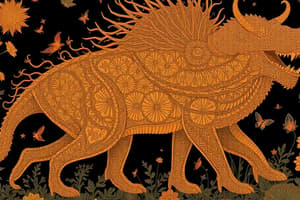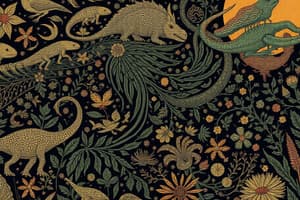Podcast
Questions and Answers
What was the main difference between Wallace's collection and Darwin's collection?
What was the main difference between Wallace's collection and Darwin's collection?
- The size of the collection
- The systematic nature of the collection (correct)
- The financial records kept
- The variety of items collected
What did Wallace collect that led him to notice variations among species?
What did Wallace collect that led him to notice variations among species?
- Dust particles
- Birds, insects, mammals, reptiles, etc. (correct)
- Plants and rocks
- Financial records
Why did Wallace decide to get a new assistant in Sarawak?
Why did Wallace decide to get a new assistant in Sarawak?
- Ali was willing to work for free
- Wallace wanted to teach someone Malay
- His sister recommended Ali
- Charles Allen was not competent enough (correct)
What did Ali start as when he began working with Wallace?
What did Ali start as when he began working with Wallace?
What significant role did Ali play for Wallace during his time in South East Asia?
What significant role did Ali play for Wallace during his time in South East Asia?
What did Wallace give to Ali at the end of his time in South East Asia?
What did Wallace give to Ali at the end of his time in South East Asia?
Who did Wallace help out in Singapore in 1856?
Who did Wallace help out in Singapore in 1856?
Flashcards are hidden until you start studying
Study Notes
Evolution and Extinction
- If living things don't evolve or change, they can't survive and become extinct if their surroundings change.
- Extinction is forever, and the species doesn't appear again.
- Human extinction is accepted, but natural extinction is not accepted.
Charles Lyell
- Lyell was a naturalist who believed that species can change a little, but not a lot.
- He believed that if conditions are right, extinct species will come back.
- He proposed that species fit their environment, but his theory contradicted fossil findings.
- Lyell's strongest follower was Darwin.
Darwin's Theory
- Darwin criticized former geologists who tried to explain the erosion of the lava and rocks of the valley by bringing into account violent action of a flood.
- He theorized that the steps of the valley could only be as a result of slow erosion of the sea.
- Darwin believed that slow erosion done by the sea over a very long time resulted in the formation of terraces.
Darwin and Fitzroy
- Myth: Media portrays a conflict between Darwin and Fitzroy, with Fitzroy being a religious creationist and Darwin being a skeptic.
- Reality: Fitzroy was not religious, and was just as scientific as Darwin.
- Fitzroy invited Darwin on the voyage and kept his own diary of observations.
Darwin's Life
- After the birth of their first child, Emma and Darwin moved to Down House in Kent in 1842.
- Darwin worked in a small corner in his study, using a chair with leg wheels and a board as a table.
- He had a lake lowered to prevent people from peeking inside the house and installed mirrors to see if visitors were coming.
The Species Problem
- John Herschel wrote to Lyell in 1836 about "the mystery of mysteries, the replacement of extinct creatures with others".
- Darwin attempts to answer this question.
- This was not a timeless problem that people had been asking, but rather a specific question that Darwin aimed to answer.
Rev. William Paley
- Rev. Paley was a clergyman who wrote a book titled Natural Theology in 1802.
- Darwin liked this book and found the argument compelling.
- Paley distinguished between systematic affinity (similarity due to descent) and analogy (similarity due to adaptation to similar environments).
Notebook D
- Notebook D (July-October 1838) was mainly about reproduction.
- Darwin asked: "What is the origin of adaptation?" and "Why is the world not overrun by one type of species?"
- He answered: Natural selection ruthlessly keeps potential growth of a population in check, and only the strong are spared.
Alfred Russel Wallace
- Wallace's collection was the most systematic natural history collection in Singapore at the time.
- He travelled with his assistants to help him collect specimens, and his collection was gigantic.
- Wallace was interested in animals, and noticed variation in the species he collected.
- He had a trusted assistant, Ali, who became his most important and trusted assistant.
Studying That Suits You
Use AI to generate personalized quizzes and flashcards to suit your learning preferences.




